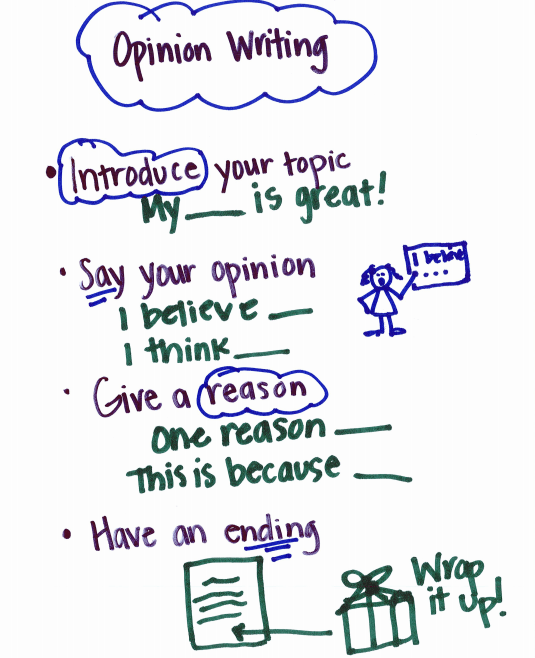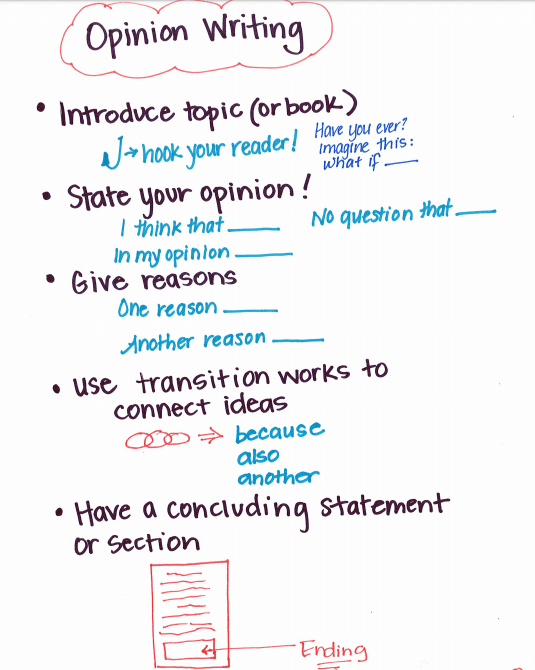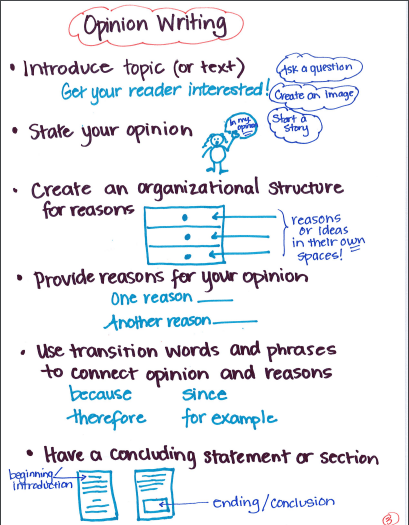Many of us have complicated relationships with standards, whether we are using the Common Core State Standards (CCSS) or a particular state’s rendition. In Connecticut, the standards are the same; the just go by the Connecticut Core Standards (CCS) as opposed to (CCSS). There’s humor there, I think, but that might be a different post.
Setting aside negativity and hostility, there is power in knowing and understanding standards because within them, we can extract teaching points, learning targets, and even success criteria. In this post, we’ll thing about how we can use the standards so set up anchor charts, as well as learning progressions in order to establish clarity and navigable pathways for writers.
Let’s look at the Grade 1 Standards for opinion writing:
- Write opinion pieces in which they introduce the topic or name the book they are writing about, state an opinion, supply a reason for the opinion, and provide some sense of closure.
What does this look like as an anchor chart, where we let students know exactly what the expectation is for them?

And what could a writing sample that meets this standard look like? This is where I would say go ahead– write one! Since I am missing my t-shirts and wishing I was back in the middle of summer, here’s a quick piece about my favorite t-shirt:
Of all my t-shirts, my dark green one is my favorite. It is really soft and feels good against my skin. I love that shirt!
Now, let’s move it up to the Grade 2 Standards.
- Write opinion pieces in which they introduce the topic or book they are writing about, state an opinion, supply reasons that support the opinion, use linking words (e.g., because, and, also) to connect opinion and reasons, and provide a concluding statement or section.
Again, we can develop an anchor chart. As you can see if you look closely at the sequential charts, I try to keep them mostly the same so that the differences are easier to spot.

Just as I move my charts along the continuum of standards, trying to use kid-friendly language, I can also move my writing sample along.
Of all my t-shirts, my dark green one is my favorite. One reason I like it is because it is really soft and feels good against my skin. Also, the color green goes with many of my skirts and shorts. I love that shirt!
And the Grade 3…
Write opinion pieces on topics or texts, supporting a point of view with reasons.
- Introduce the topic or text they are writing about, state an opinion, and create an organizational structure that lists reasons.
- Provide reasons that support the opinion.
- Use linking words and phrases (e.g., because, therefore, since, for example) to connect opinion and reasons.
- Provide a concluding statement or section.

Do you have a favorite shirt? I do! Mine is my dark green one.
One reason I like it is because it is really soft and feels good against my skin. Some of my other shirts rub or feel scratchy, but this one is smooth.
Also, the color green goes with many of my skirts and shorts. I wear a lot of jeans in the summer, as well as khakis and white pants. Dark green goes with all of those colors, so it doesn’t matter which shorts, skirts, or pants I wear.
I love that shirt! It’s a challenge to make sure it’s always clean.
Working through this exercise, we can appreciate the jump there is between Grade 2 and Grade 3, so much so that Grade 3 requires bullets in order to describe the standards.
With these charts and writing samples in hand, we have many options for instruction. We can offer students a choice of charts, we can challenge students to set goals insofar as how they’ll model their own writing, we can ask students to create charts based on the writing samples… and I’m sure there are more. I appreciate about the clarity and the progressive nature that the writing standards offer, and students appreciate the clear trail-markers and criteria for success that these tools provide.


What clear, digestible view to a standard in action vertically! I think it’s so important for teachers to know the expectations not only in their grade but across grades. This piece supports that! Thanks for sharing!
LikeLike